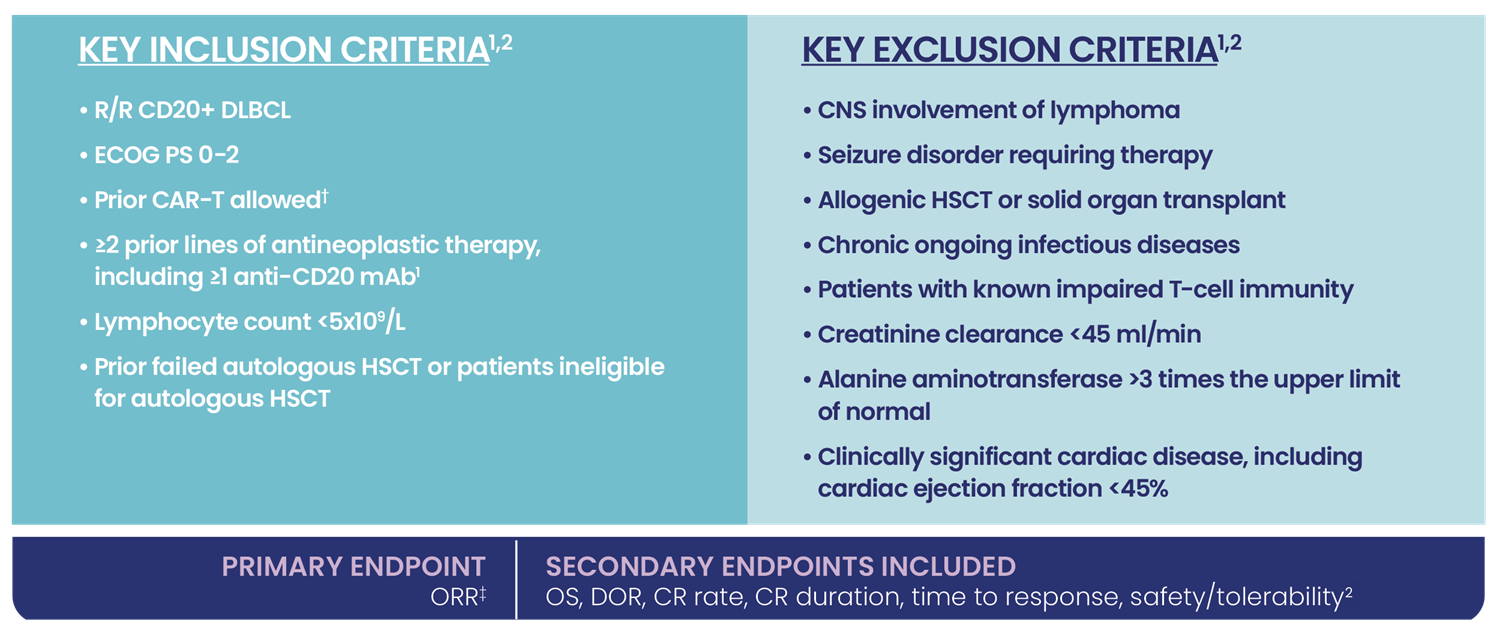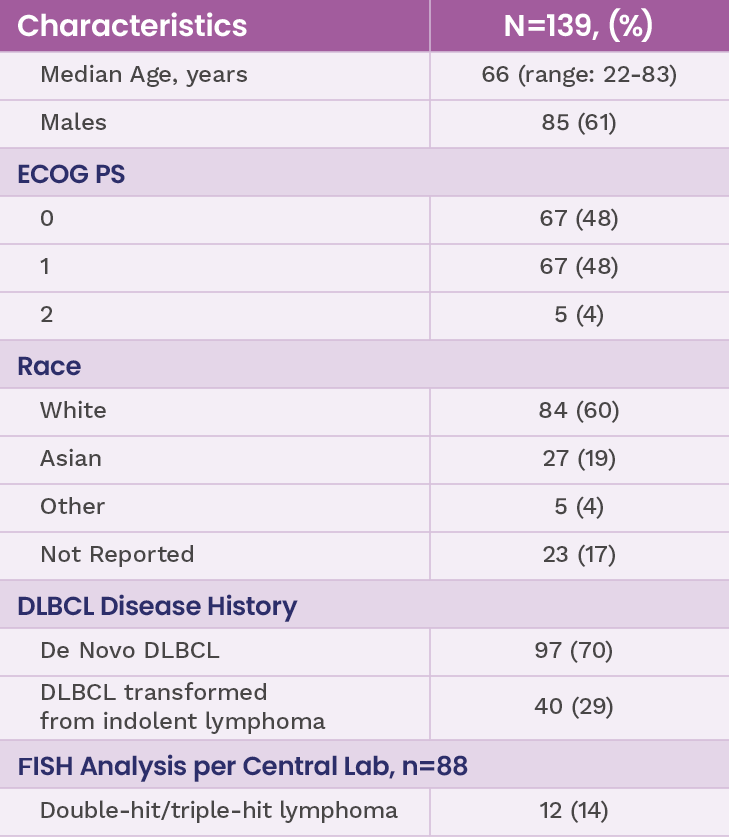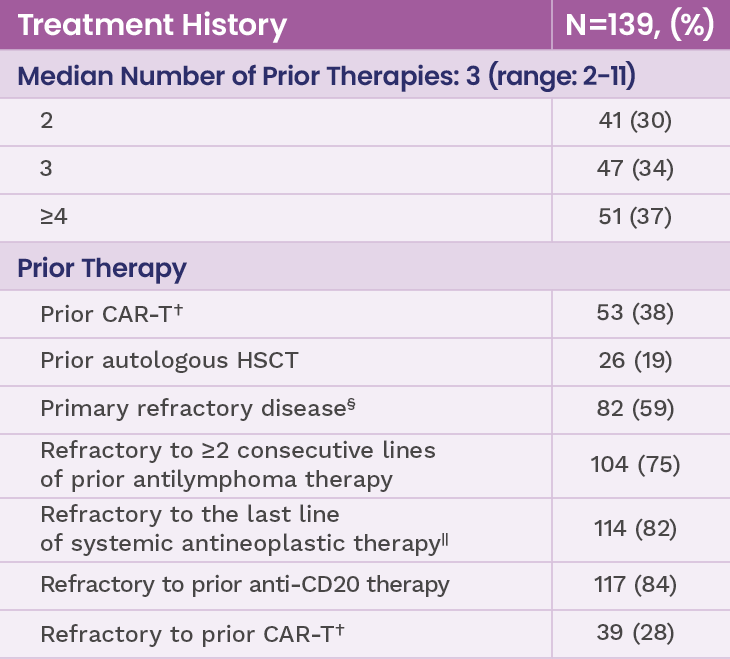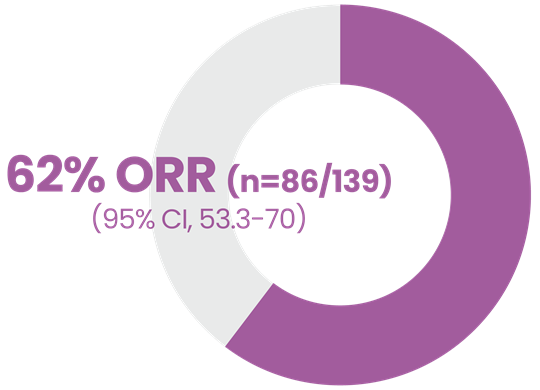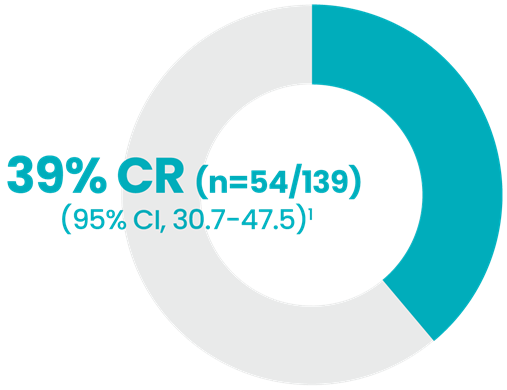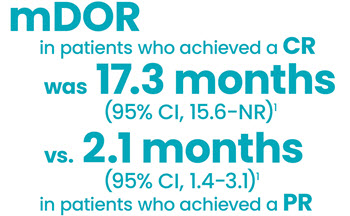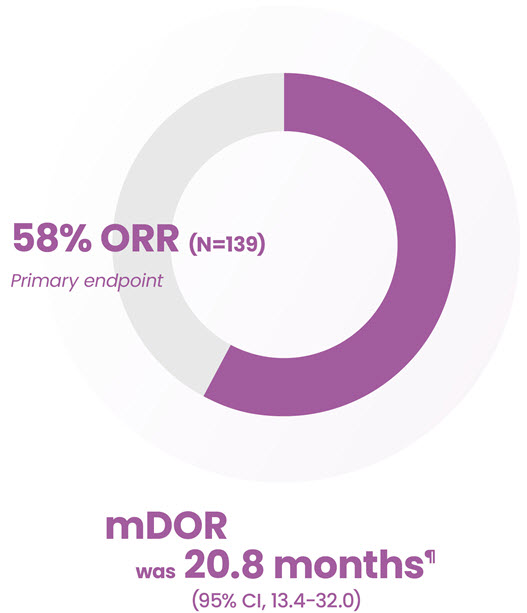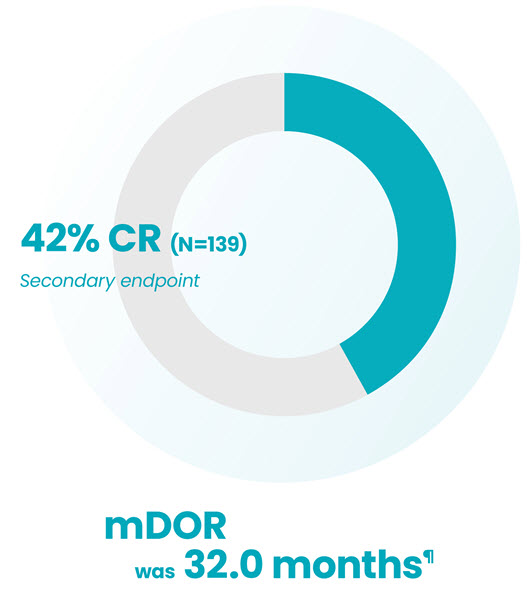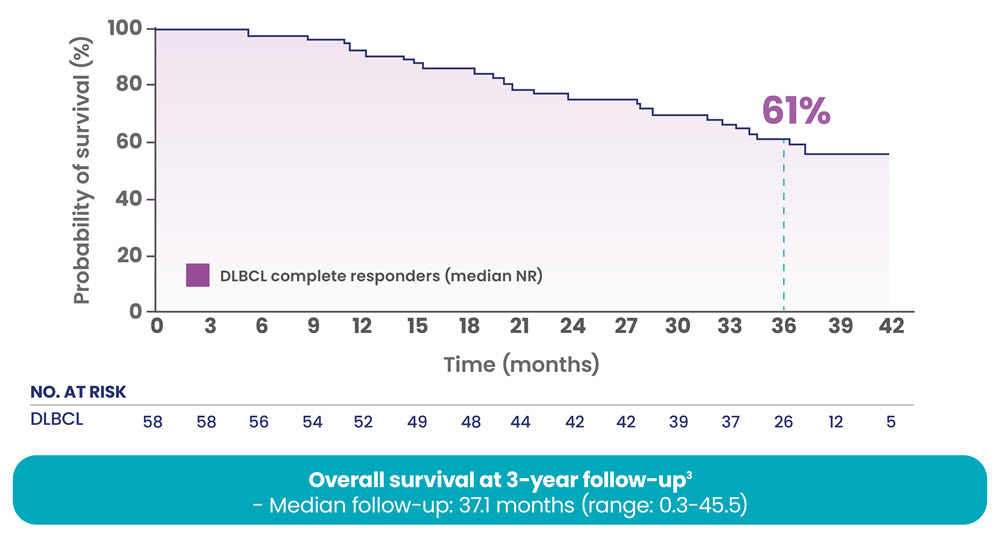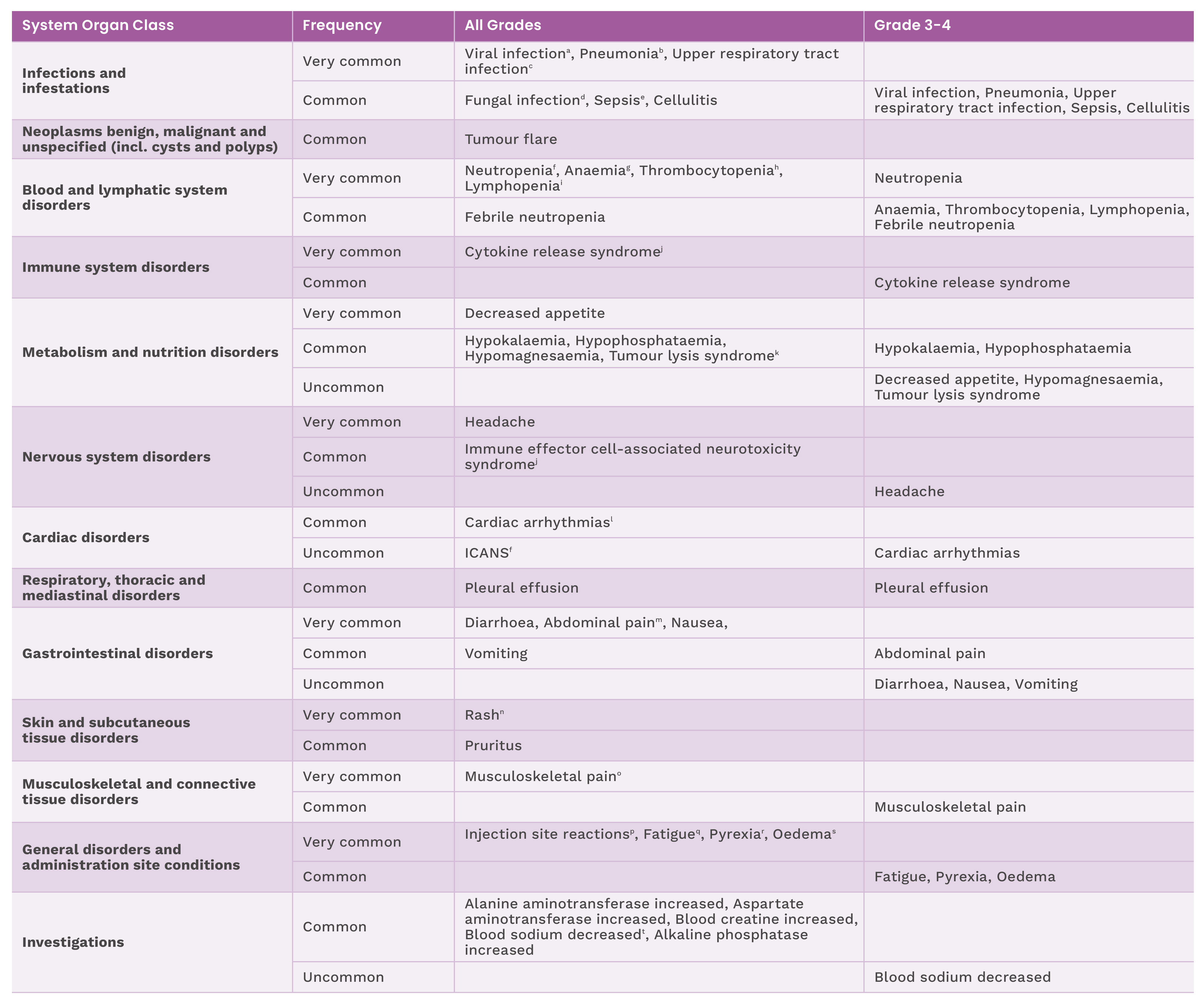EPCORETM NHL-11
EPCORETM NHL-1 was an open-label, multicohort, multicentre, single-arm, phase 2 (dose expansion) trial that evaluated Tepkinly as monotherapy in 139 patients with CD20-expressing DLBCL, after two or more lines of systemic therapy.2*
Efficacy results from the EPCORETM NHL-1 study1
The median follow-up time was 15.7 months (range: 0.3-23.5)
Tepkinly has a generally manageable safety profile1
The safety of Tepkinly was evaluated in a non-randomised, single-arm study in 382 patients with R/R LBCL (n=167), follicular lymphoma (n=129) and follicular lymphoma (3-step step-up dose schedule n=86) after 2 or more lines of systematic therapy and included all the patients who enrolled to the 48 mg dose and received at least one dose of Tepkinly. The following adverse reactions have been reported with Tepkinly during clinical studies and post marketing experience.
The following adverse reactions have been reported with epcoritamab during clinical studies and post-marketing experience.
Adverse reactions reported in patients in EPCORE™ NHL-11
Adverse reactions for Tepkinly from clinical studies are listed by MedDRA system organ class and are based on the following convention: very common (≥1/10); common (≥1/100 to <1/10); uncommon (≥1/1,000 to <1/100); rare (≥1/10,000 to <1/1,000); and very rare (<1/10,000).
*EPCORE™ NHL-1 enrolled patients with ECOG status 0-2, de novo DLBCL, DLBCL transformed from indolent lymphoma, CAR-T naïve, prior CAR-T, and primary refractory disease.
†Patients who had relapsed or were refractory to prior CAR-T cell therapy were eligible if ≥30 days since last CAR-T cell treatment.
‡ORR was determined by Lugano criteria (2014) as assessed by Independent Review Committee (IRC)
§A patient is considered to be primary refractory if they are refractory to frontline anti-lymphoma therapy.
||A patient is considered to be refractory if they experience disease progression or stable disease as best response or disease progression within 6 months after therapy completion.
¶Analysed using the Kaplan-Meier method.
aViral infection includes COVID-19, cytomegalovirus chorioretinitis, cytomegalovirus colitis, cytomegalovirus infection, cytomegalovirus infection reactivation, gastroenteritis viral, herpes simplex, herpes simplex reactivation, herpes virus infection, herpes zoster, oral herpes, post-acute COVID-19 syndrome, and varicella zoster virus infection.
bPneumonia includes COVID-19 pneumonia and pneumonia.
cUpper respiratory tract infection includes laryngitis, pharyngitis, respiratory syncytial virus infection, rhinitis, rhinovirus infection, and upper respiratory tract infection.
dFungal infection includes candida infection, oesophageal candidiasis, oral candidiasis and oropharyngeal candidiasis.
eSepsis includes bacteraemia, sepsis, and septic shock.
fNeutropenia includes neutropenia and neutrophil count decreased.
gAnaemia includes anaemia and serum ferritin decreased.
hThrombocytopenia includes platelet count decreased and thrombocytopenia.
iLymphopenia includes lymphocyte count decreased and lymphopenia.
jEvents graded using American Society for Transplantation and Cellular Therapy (ASTCT) consensus criteria.
kClinical Tumour Lysis Syndrome was graded based on Cairo-Bishop.
lCardiac arrhythmias include bradycardia, sinus bradycardia, sinus tachycardia, supraventricular tachycardia, and tachycardia.
mAbdominal pain includes abdominal discomfort, abdominal pain, abdominal pain lower, abdominal pain upper, and abdominal tenderness.
nRash includes rash, rash erythematous, rash macular, rash maculo-papular, rash popular, rash pruritic, rash pustular and rash vesicular.
oMusculoskeletal pain includes back pain, bone pain, flank pain, musculoskeletal chest pain, musculoskeletal pain, myalgia, neck pain, non-cardiac chest pain, pain, pain in extremity, and spinal pain.
pinjection site reactions include injection site bruising, injection site erythema, injection site hypertrophy, injection site inflammation, injection site mass, injection site nodule, injection site oedema, injection site pain, injection site pruritus, injection site rash, injection site reaction, injection site swelling, and injection site urticaria.
qFatigue includes asthenia, fatigue, and lethargy.
rPyrexia includes body temperature increased and pyrexia.
sOedema includes face oedema, generalised oedema, oedema, oedema peripheral, peripheral swelling, swelling, decreased and hyponatraemia. and swelling face.
tBlood sodium decreased includes blood sodium decreased and hyponatraemia.
Abbreviations
3L+=third-line plus; BsAB; bispecific antibody; CAR-T=chimeric antigen T cell; CD20=cluster of differentiation 20; CI=confidence interval; CNS=central nervous system; CR=complete response; CRS=cytokine release syndrome; DLBCL=diffuse large B-cell lymphoma; DOR=duration of response; ECOG PS=Eastern Cooperative Oncology Group performance status; FISH=fluorescence in situ hybridisation; HSCT=haematopoietic stem cell transplantation; ICANS=immune effector cell-associated neurotoxicity syndrome; mAb=monoclonal antibody; mDOCR=median duration of complete response; mDOR=median duration of response; NHL=non-Hodgkin lymphoma; NR=not reached; ORR=overall response rate; OS=overall survival; PR; partial response; R/R=relapsed/refractory; TLS=tumour lysis syndrome.
References
- Tepkinly Summary of Product Characteristics
- Thieblemont C et al. J Clin Oncol. 2022; 41(12): 2238-47.
- Vose J, et al. ASH 2024 P4480.
By clicking the link above, you will leave the AbbVie Pro website and be taken to the eMC PI portal website.
UK-EPCOR-250230. Date of preparation: August 2025.
Adverse events should be reported. Reporting forms and information can be found at yellowcard.mhra.gov.uk.
Adverse events should also be reported to AbbVie on GBPV@abbvie.com








